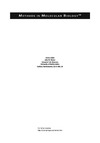Protein modifications and changes made to them, as well as the quantities of expressed proteins, can define the various functional stages of the cell. Accordingly, perturbations can lead to various diseases and disorders. As a result, it has become paramount to be able to detect and monitor post-translational modifications and to measure the abundance of proteins within the cell with extreme sensitivity. While protein identification is an almost routine requirement nowadays, reliable techniques for quantifying unmodified proteins (including those that escape detection under standard conditions, such as protein isoforms and membrane proteins) is not routine. Quantitative Methods in Proteomics gives a detailed survey of topics and methods on the principles underlying modern protein analysis, from statistical issues when planning proteomics experiments, to gel-based and mass spectrometry-based applications. The quantification of post-translational modifications is also addressed, followed by the “hot” topics of software and data analysis, as well as various overview chapters which provide a comprehensive overview of existing methods in quantitative proteomics. Written in the successful Methods in Molecular Biology™ series format, chapters include introductions to their respective topics, lists of the necessary materials and reagents, step-by-step, readily reproducible protocols, and notes on troubleshooting and avoiding known pitfalls.
Authoritative and easily accessible, Quantitative Methods in Proteomics serves as a comprehensive and competent overview of the important and still growing field of quantitative proteomics.
 |
|
О проекте
|
|
О проекте


